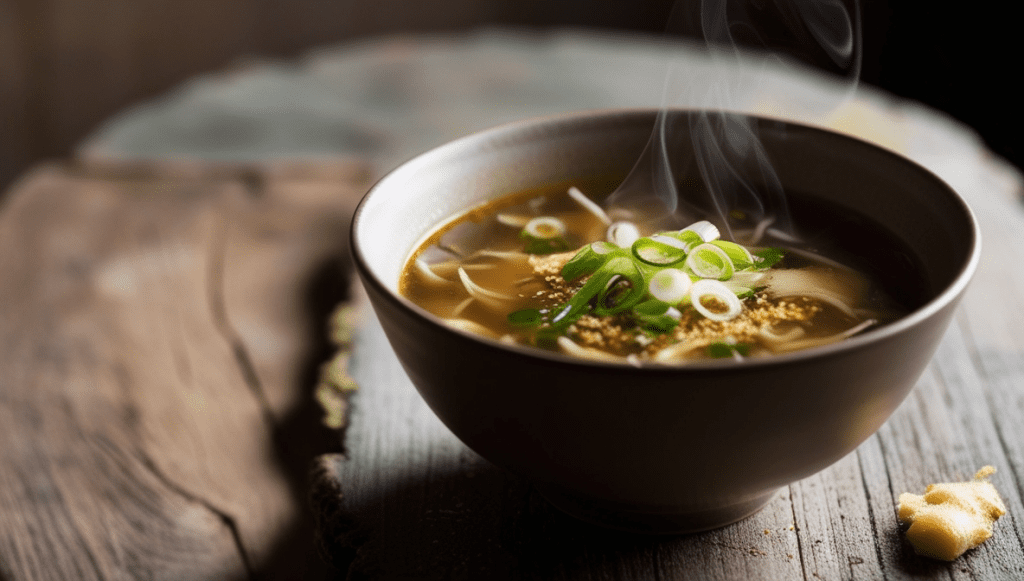
Here’s a simple and delicious Low Sodium Miso Soup recipe that maintains the comforting flavors of traditional miso soup while being mindful of sodium content.
Low Sodium Miso Soup Recipe
Ingredients
- 2 cups water
- 1 tsp dried wakame seaweed (rehydrated)
- 2/3 cup onion, thinly sliced
- 1/2 cup carrot, thinly sliced
- 2 tbsp Eden Organic Shiro Miso (or another low-sodium miso, pureed in 2 tbsp water)
- 1/4 cup green onions, finely sliced
- Optional ingredients: tofu (cubed), shiitake or maitake mushrooms, leafy greens, daikon, lotus root, leeks, root vegetables, cooked noodles, or mochi.
Instructions
- Prepare the Seaweed: Soak the dried wakame in warm water for about 5 minutes to rehydrate. Drain and set aside.
- Cook the Vegetables: In a medium pot, bring the 2 cups of water to a boil. Add the sliced carrots and onions. Boil for about 5-7 minutes until the vegetables are tender.
- Add Wakame: Stir in the rehydrated wakame seaweed and let it cook for an additional minute.
- Incorporate Miso: Lower the heat to very low and add the pureed miso mixture to the pot. Stir gently to combine and let it barely simmer for about 2 minutes. Avoid boiling after adding miso to preserve its beneficial probiotics.
- Garnish and Serve: Remove from heat and garnish with finely sliced green onions. If desired, add cubed tofu or any other optional ingredients before serving.
Tips
- Adjusting Flavor: Since low-sodium miso can be milder in flavor, you may want to experiment with adding garlic powder or white pepper for additional depth.
- Stock Options: Using homemade vegetable stock can enhance flavor without adding too much sodium.
- Storage: Leftover soup can be stored in an airtight container in the refrigerator for up to 3 days; reheat gently on the stove.
What Are Some Creative Ways to Make Low-Sodium Miso Soup More Flavorful?
- Use Homemade Vegetable Broth: Instead of water, use a homemade low-sodium vegetable broth to enhance the flavor.
- Add Aromatics: Incorporate garlic, ginger, or shallots for added depth.
- Incorporate Umami Ingredients: Consider adding mushrooms (like shiitake), nutritional yeast, or a splash of low-sodium soy sauce or tamari for extra umami flavor.
- Spice It Up: Add a pinch of red pepper flakes or a dash of chili oil for heat.
- Herbs and Greens: Fresh herbs like cilantro or basil can brighten the soup, while leafy greens like spinach or bok choy add flavor and nutrition.
Can I Use Vegetable Broth Instead of Chicken Broth for Miso Soup?
Yes, you can absolutely use vegetable broth instead of chicken broth for miso soup. Vegetable broth will provide a rich flavor while keeping the soup vegetarian and vegan-friendly. Just ensure that the vegetable broth is low in sodium if you’re aiming for a low-sodium version.
What Are Some Good Low-Sodium Alternatives to Traditional Miso Paste?
- Chickpea Miso: This is a great soy-free option that is typically lower in sodium.
- White Miso: Look for brands that specifically label their miso as low sodium, such as Eden Organic’s Shiro Miso, which has lower sodium content compared to darker varieties.
- Homemade Miso Paste: You can make your own miso paste using blended fermented soybeans with less salt.
How Can I Make Miso Soup Without Using Seaweed?
If you prefer to make miso soup without seaweed, you can:
- Use Vegetable Broth: Start with a flavorful vegetable broth as the base.
- Add Mushrooms: Incorporate shiitake or button mushrooms for umami flavor.
- Include Tofu and Vegetables: Add cubed tofu and your choice of vegetables like carrots, green onions, or bok choy to create a hearty soup.
What Are Some Protein-Rich Ingredients I Can Add to Low-Sodium Miso Soup?
- Tofu: A classic addition that provides protein and absorbs the flavors of the soup.
- Tempeh: This fermented soy product adds a nutty flavor and is high in protein.
- Edamame: Shelled edamame can be added for a protein boost and vibrant color.
- Chickpeas: These can be added for extra protein and texture.
- Seitan: A wheat-based meat alternative that is high in protein and can be diced into the soup.
Is Miso Soup Gluten Free?
Miso soup can be gluten-free, but it depends on the ingredients used. Traditional miso paste may contain gluten if made with barley or other grains. To ensure the soup is gluten-free, look for miso paste labeled as gluten-free and use tamari instead of soy sauce.
Is Miso Soup Vegetarian?
Yes, miso soup is typically vegetarian if made with vegetable broth and does not include fish-based ingredients. Many recipes use kombu (a type of seaweed) to create a vegetarian dashi, making it suitable for vegetarians.
Is Miso Soup Vegan?
Miso soup can be vegan if prepared without any animal products. Most traditional recipes can easily be adapted to be vegan by using vegetable broth and ensuring that no fish or animal-derived ingredients are included.
What Does Miso Soup Taste Like?
Miso soup has a savory, umami flavor profile that is both rich and comforting. The primary taste comes from the miso paste, which can range from sweet to salty depending on the type used (white, yellow, or red). The addition of ingredients like tofu and seaweed enhances its depth and complexity.
Can Dogs Have Miso Soup?
While small amounts of miso may not be harmful to dogs, it is generally not recommended due to its high sodium content and potential for digestive upset. Always consult with a veterinarian before introducing new foods into your dog’s diet.

Is Miso Soup Keto?
Miso soup can be considered keto-friendly as it is low in carbohydrates, primarily depending on the ingredients used. The main components—miso paste, tofu, and vegetables—are low in carbs, making it suitable for a ketogenic diet.
Is Miso Soup Good When Sick?
Miso soup is often considered comforting and soothing when feeling unwell due to its warm temperature and nutritional benefits. The probiotics in miso can support gut health, while the broth provides hydration. It’s a popular choice for those recovering from illness.
Miso Soup Calories
A typical serving of miso soup contains approximately 69 calories per 304 grams. The calorie count can vary based on the ingredients used; for example, basic miso soup made with just water and miso paste may have around 40 calories, while adding tofu and vegetables can raise it to 60-80 calories.
Calories in a Miso Soup
The calorie content of miso soup can fluctuate based on what you add. For instance:
- Basic Miso Soup: Approximately 40 kcal.
- With Tofu and Vegetables: About 60-80 kcal per serving.
- Seafood Variants: May increase further depending on the type and amount of seafood included.
These suggestions will help you create a flavorful and nutritious low-sodium miso soup tailored to your preferences! Enjoy your cooking!











